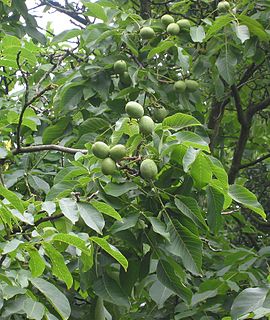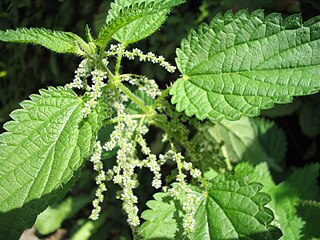
The Cucurbitales are an order of flowering plants, included in the rosid group of dicotyledons. This order mostly belongs to tropical areas, with limited presence in subtropic and temperate regions. The order includes shrubs and trees, together with many herbs and climbers. One major characteristic of the Cucurbitales is the presence of unisexual flowers, mostly pentacyclic, with thick pointed petals. The pollination is usually performed by insects, but wind pollination is also present.

Nymphaeaceae is a family of flowering plants, commonly called water lilies. They live as rhizomatous aquatic herbs in temperate and tropical climates around the world. The family contains five genera with about 70 known species. Water lilies are rooted in soil in bodies of water, with leaves and flowers floating on or emergent from the surface. Leaves are round, with a radial notch in Nymphaea and Nuphar, but fully circular in Victoria and Euryale. It is the national flower of Bangladesh.

Fagaceae is a family of flowering plants that includes beeches and oaks, and comprises eight genera with about 927 species. Fagaceae in temperate regions are mostly deciduous, whereas in the tropics, many species occur as evergreen trees and shrubs. They are characterized by alternate simple leaves with pinnate venation, unisexual flowers in the form of catkins, and fruit in the form of cup-like (cupule) nuts. Their leaves are often lobed and both petioles and stipules are generally present. Their fruits lack endosperm and lie in a scaly or spiny husk that may or may not enclose the entire nut, which may consist of one to seven seeds. In the oaks, genus Quercus, the fruit is a non-valved nut called an acorn. The husk of the acorn in most oaks only forms a cup in which the nut sits. Other members of the family have fully enclosed nuts. Fagaceae is one of the most ecologically important woody plant families in the Northern Hemisphere, as oaks form the backbone of temperate forest in North America, Europe, and Asia and one of the most significant sources of wildlife fodder.

The Araliaceae are a family of flowering plants composed of about 43 genera and around 1500 species consisting of primarily woody plants and some herbaceous plants. The morphology of Araliaceae varies widely, but it is predominantly distinguishable based on its woody habit, tropical distribution, and the presence of simple umbels.

Caryophyllaceae, commonly called the pink family or carnation family, is a family of flowering plants. It is included in the dicotyledon order Caryophyllales in the APG III system, alongside 33 other families, including Amaranthaceae, Cactaceae, and Polygonaceae. It is a large family, with 81 genera and about 2,625 known species.

Amaranthaceae is a family of flowering plants commonly known as the amaranth family, in reference to its type genus Amaranthus. It includes the former goosefoot family Chenopodiaceae and contains about 165 genera and 2,040 species, making it the most species-rich lineage within its parent order, Caryophyllales.

Droseraceae is a family of carnivorous flowering plants, also known as the sundew family. It consists of approximately 180 species in three extant genera. Representatives of the Droseraceae are found on all continents except Antarctica.

The Juglandaceae are a plant family known as the walnut family. They are trees, or sometimes shrubs, in the order Fagales. Members of this family are native to the Americas, Eurasia, and Southeast Asia.

Zygophyllaceae is a family of flowering plants that contains the bean-caper and caltrop. The family includes around 285 species in 22 genera.

The Urticaceae are a family, the nettle family, of flowering plants. The family name comes from the genus Urtica. The Urticaceae include a number of well-known and useful plants, including nettles in the genus Urtica, ramie, māmaki, and ajlai.

Gesneriaceae, the gesneriad family, is a family of flowering plants consisting of about 152 genera and ca. 3,540 species in the tropics and subtropics of the Old World and the New World, with a very small number extending to temperate areas. Many species have colorful and showy flowers and are cultivated as ornamental plants.

Scilloideae is a subfamily of bulbous plants within the family Asparagaceae. Scilloideae is sometimes treated as a separate family Hyacinthaceae, named after the genus Hyacinthus. Scilloideae or Hyacinthaceae include many familiar garden plants such as Hyacinthus (hyacinths), Hyacinthoides (bluebells), Muscari and Scilla and Puschkinia. Some are important as cut flowers.

The Marantaceae are a family, the arrowroot family, of flowering plants consisting of 31 genera and around 530 species, defining it as one of the most species-rich families in its order. Species of this family are found in lowland tropical forests of Africa, Asia, and the Americas. The majority (80%) of the species are found in the American tropics, followed by Asian (11%) and African (9%) tropics. They are commonly called the prayer-plant family and are also known for their unique secondary pollination presentation.

Saxifragaceae is a family of herbaceous perennial flowering plants, within the core eudicot order Saxifragales. The taxonomy of the family has been greatly revised and the scope much reduced in the era of molecular phylogenetic analysis. The family is divided into ten clades, with about 640 known species in about 35 accepted genera. About half of these consist of a single species, but about 400 of the species are in the type genus Saxifraga. The family is predominantly distributed in the northern hemisphere, but also in the Andes in South America.

The Papaveraceae are an economically important family of about 42 genera and approximately 775 known species of flowering plants in the order Ranunculales, informally known as the poppy family. The family is cosmopolitan, occurring in temperate and subtropical climates, but almost unknown in the tropics. Most are herbaceous plants, but a few are shrubs and small trees. The family currently includes two groups that have been considered to be separate families: Fumariaceae and Pteridophyllaceae.

Phyllanthaceae is a family of flowering plants in the eudicot order Malpighiales. It is most closely related to the family Picrodendraceae.

Pandanaceae is a family of flowering plants native to the tropics and subtropics of the Old World, from West Africa through the Pacific. It contains 982 known species in five genera, of which the type genus, Pandanus, is the most important, with species like Pandanus amaryllifolius and karuka being important sources of food. It is an ancient family dating from the early to mid-Cretaceous. This is a family that is not-well studied.

The Rafflesiaceae are a family of rare parasitic plants comprising 36 species in 3 genera found in the tropical forests of east and southeast Asia, including Rafflesia arnoldii, which has the largest flowers of all plants. The plants are endoparasites of vines in the genus Tetrastigma (Vitaceae) and lack stems, leaves, roots, and any photosynthetic tissue. They rely entirely on their host plants for both water and nutrients, and only then emerge as flowers from the roots or lower stems of the host plants.

The family Apodanthaceae comprises about 10 species of endoparasitic herbs. They live in the branches or stems of their hosts, emerging only to flower and fruit. The plants produce no green parts and do not carry out any photosynthesis. There are two genera: Pilostyles and Apodanthes. A third genus, Berlinianche, was never validly published. Mitochondrial and nuclear DNA sequences confidently place the Apodanthaceae in the Cucurbitales, where they also fit well in terms of their flower morphology.

Hydrostachys is a genus of about 22 species of flowering plants native to Madagascar and southern and central Africa. It is the only genus in the family Hydrostachyaceae. All species of Hydrostachys are aquatic, growing on rocks in fast-moving water. They have tuberous roots, usually pinnately compound leaves, and highly reduced flowers on dense spikes.




















